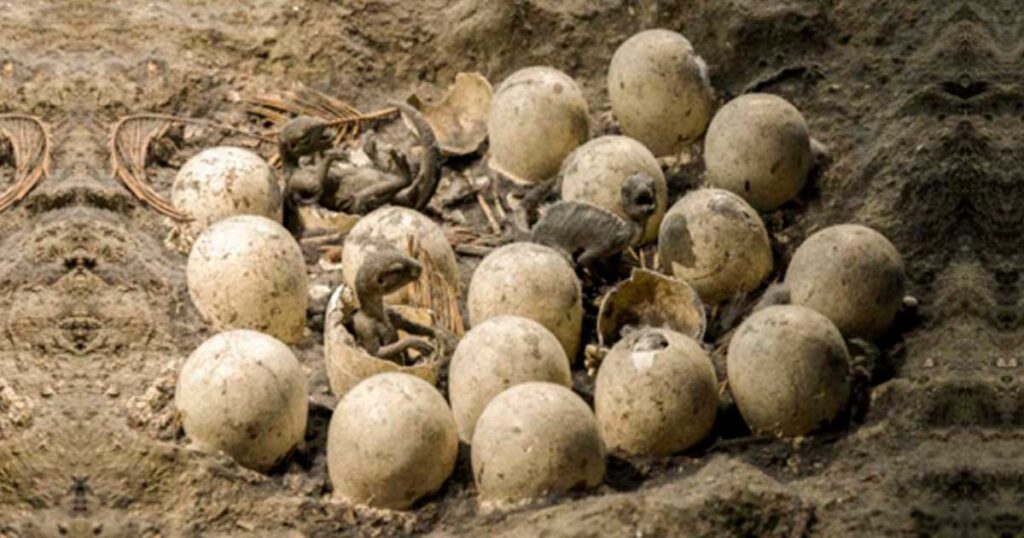
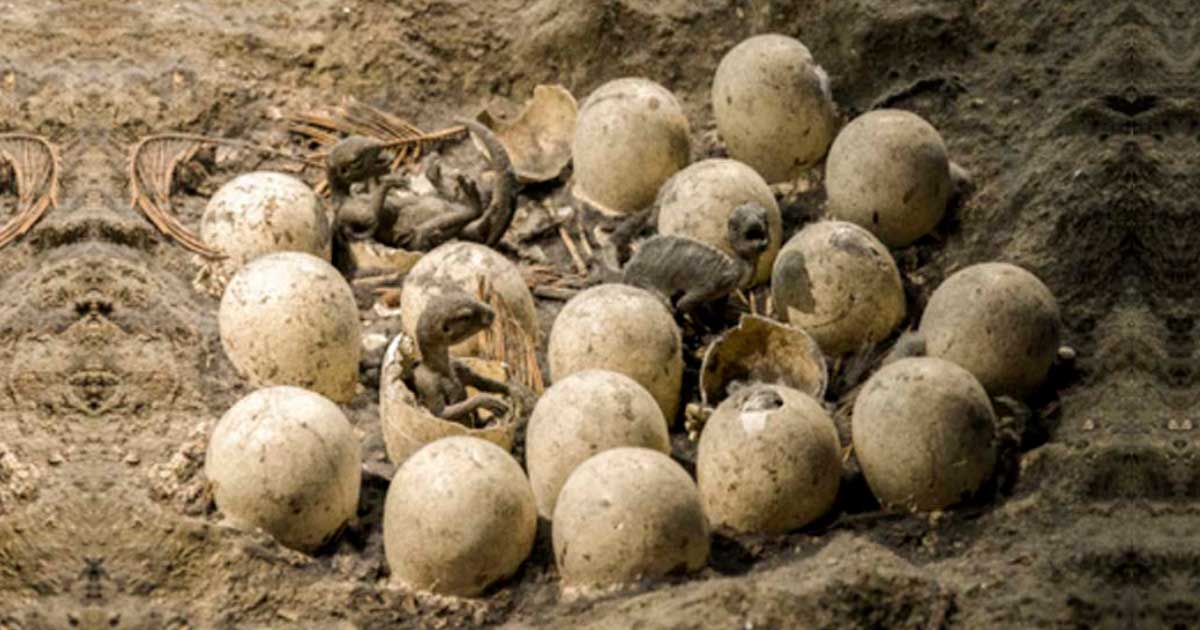
During explorations near the city of Dhar in the state of Madhya Pradesh in India, paleontologists made a remarkable discovery. The scientists found an extensive collection of fossilized dinosaur eggs that belonged to a giant plant-eating genus of reptile known as the titanosaur. These eggs were likely laid shortly before the extinction event that wiped out the planet’s remaining dinosaurs 66 million years ago.
“Our research has revealed the presence of an extensive hatchery of titanosaur sauropod dinosaurs in the study area and offers new insights into the conditions of nest preservation and reproductive strategies of titanosaur sauropod dinosaurs just before they went extinct,” said study co-lead author Dr. Harsha Dhiman, a geologist from the University of Delhi, in a statement published in the Daily Mail Online.
The titanosaur eggs were so well-preserved in the rock and soil that degraded protein fragments were detected inside them. Their pristine condition is what makes this such a rare and valuable discovery for paleontologists attempting to piece together the history of one of the largest animals to ever walk the face of the Earth.
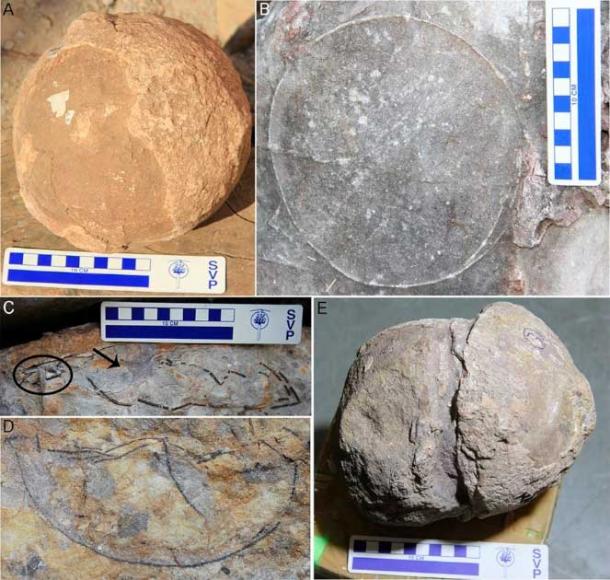
Field photographs of eggs and egg outlines showing various features. (A) Completely unhatched egg from the clutch P43. (B) Almost fully intact circular outline of egg possibly indicating it to be unhatched and no loose eggshells are found in the clutch P6. (C) Compressed egg from clutch DR10 showing hatching window (arrow showing gap) and few eggshells collected just around the hatching window (circled) which possibly represent the remnants of hatching window. (D) Egg from clutch P26 showing curved outline. (E) Deformed egg from clutch P30 showing egg surfaces slipping past each other. (Dhiman et al., 2023, PLOS ONE/ CC-BY 4.0 )
The mature, coconut-sized eggs were distributed among 92 nests, and there were 256 titanosaur eggs discovered overall. Combined with dinosaur nests found in the upper Narmada Valley in the east and near the city of Balasinor to the west, the nesting sites in central India are part of a 600-mile- (1,000-kilometer)-long corridor known as the Lameta Formation, which is one of the largest dinosaur hatcheries found anywhere in the world.
The Indian scientists who discovered and studied the fossilized eggs have just published the results of their research in the journal PLOS One.
Paleontologists first found dinosaur eggs in this area in the 1990s, and the eggs discussed in this new study were unearthed during excavations and field work that took place in Madhya Pradesh in 2017, 2018 and 2020.
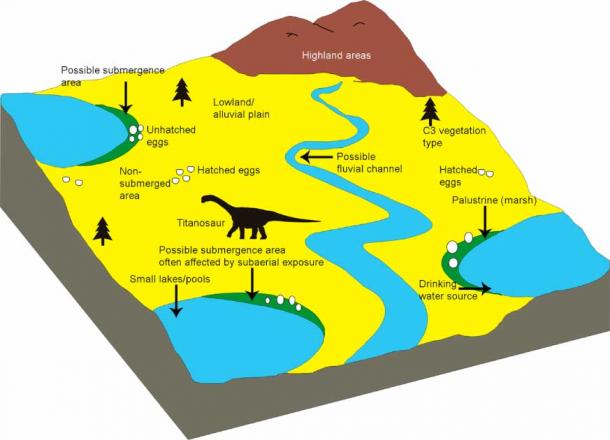
A block diagram showing the interpreted depositional environment of the Lameta Formation in the study areas. It is inferred that some of the clutches were laid close to the banks of the aquatic bodies (lakes/ponds) while others were deposited away from the lakes or ponds. The clutches laid close to the margins were prone to frequent submergence by water and thus got buried under sediment and remained unhatched, while the clutches laid away from the margins could hatch and hence showed more broken eggshells. (Dhiman et al., 2023, PLOS ONE/ CC-BY 4.0)
The Nesting Behavior of the Titanosaur Revealed
As suggested by the first part of its name, the titanosaur was a gigantic genus of long-necked sauropod that occupied central India in large numbers in the Late Cretaceous period. Fossilized titanosaur remains were first discovered in the Lameta region in the 19th century, and up to that time no dinosaur fossils of any type had ever been found in the country of India. The titanosaur roamed the lands of modern India from approximately 145 million years ago up until an asteroid hit the earth in the Yucatan peninsula and killed off the last of the dinosaurs in 66 million BC , and it is now known that this genus populated all the continents of the earth except Antarctica.
The eggs recovered from the Dhar site came from six different titanosaur species, the researchers say. The eggs were between six and seven inches (15 and 17 centimeters) in diameter, distributed in numbers that ranged from one to 20 in a variety of different nests.
Most of the nests were placed quite close together, which according to University of Delhi geologist and study co-lead author Dr. Guntupalli Prasad suggests that titanosaurs were rather neglectful as parents.
“Since titanosaurs were huge in size, closely spaced nests would not have allowed them to visit the nests to maneuver and incubate the eggs or feed the hatchlings … as the parents would step on the eggs and trample them.”
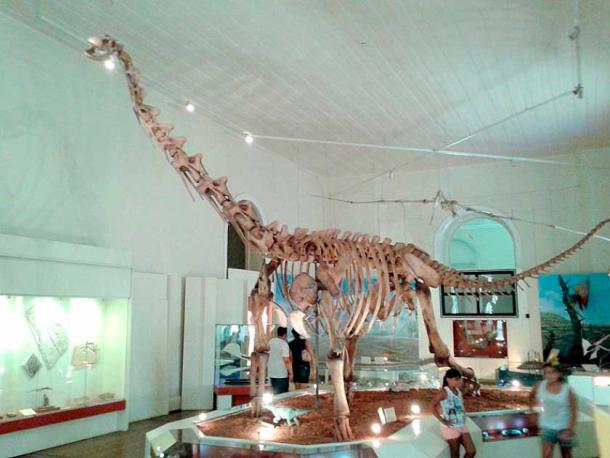
Titanosaurus replica at the National Museum of Brasil. (CC BY-SA 4.0)
A telling Discovery
From studying the characteristics of the eggs and the nests, the Indian scientists have found similarities between the nesting behaviors of the extinct sauropod and those of modern birds and crocodiles. Just like these creatures, titanosaurs laid their eggs together in large colonies or rookeries.
“Such nesting colonies would have been a sight to see back in the Cretaceous where the landscape would have been dotted by a huge number of large dinosaur nests,” Dr. Darla Zelenitsky, a dinosaur paleobiologist from the University of Calgary in Canada who was not involved in the new study, told CNN.
Prasad noted that one egg in particular, which is of a type known as an ovum-in-ovo or egg-in-egg, suggested that titanosaurs might have laid eggs sequentially, like many birds to today. The ovum-in-ovo label describes a double egg in which only one of the eggs is fully formed, and this is a phenomenon that can only occur if eggs are being laid one at a time.
“Sequential laying is the release of eggs one by one with some time gap in between two laying events. This is seen in birds. Modern reptiles, for example turtles and crocodiles, on the other hand, lay all eggs together as a clutch,” Dr. Prasad explained.
Why Was This a Center for Dinosaur Hatcheries?
In the Late Cretaceous period, the area of the Lameta Formation would have been marshy and flat, and the titanosaurs would have dug out shallow pits on semi-dry land in which to lay their eggs. This is exactly what crocodiles do now, as they normally occupy the same type of environment. The dinosaurs would have needed to lay their eggs relatively close to water, to prevent them from drying out before they could hatch.
Unlike birds and crocodiles, titanosaurs would not have stayed around to sit on and protect their eggs. As the shape and design of their nests reveals, they would have laid their eggs and then moved on, leaving their babies to hatch on their own and fend for themselves once they were born. No fossils from juvenile titanosaurs have been found in the Lameta Formation, which suggests that the youngest versions of these dinosaurs matured quickly and left their nesting areas as soon as possible.
Remembering the Titanic Sauropods
More than 40 species of titanosaur have been found on every continent except Antarctica. But paleontologists only knew what to look for after the original discovery of the genus in central India, where the creature likely lived in its greatest numbers.
The titanosaurs were the last surviving member of the long-necked sauropod clade, and much of what is known about this type of dinosaur has been derived from the study of titanosaur fossils. Paleontologists have no doubt that more titanosaur fossils are waiting to be found in the Lameta Formation, and each new discovery has the potential to reveal fresh and fascinating secrets about the lives and lifestyles of these humongous creatures.